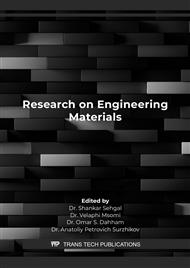[1]
Daugherty RL. Composite leaf springs in heavy truck applications. Composite materials. In: Proceedings of Japan–US conference, Tokyo; 1981. p.529–38.
Google Scholar
[2]
Mc Geehin P. Composites in transportation: design and current developments. Mater Des April 1982;3(2):378–87.
Google Scholar
[3]
Belevi M, Kochan C. Experimental investigation of fiber reinforced composite leaf springs. Materialpruefung/Mater Test 2017;59:853–8.
DOI: 10.3139/120.111078
Google Scholar
[4]
Singh H, Brar GS. Characterization and investigation of mechanical properties of composite materials used for leaf spring. Mater Today Proc 2018;5:5857–63.
DOI: 10.1016/j.matpr.2017.12.183
Google Scholar
[5]
Charrier JM, Cloutier A, Comte R, Connolly R, Limoges R. Fabrication and testing of hollow reinforced plastic (RP) beams of circular and elliptic cross sections. In: Proceeding of 40th annual conference SPI Paper 5-D; (1985).
Google Scholar
[6]
Charrier JM, Connolly R, Maki SG, Plourde MA. End loading of filament wound circular and elliptic FRP rings-spring element applications. In: Proceeding of 41st annual conference. SPI Paper 24-B; (1986).
Google Scholar
[7]
Mallick PK. Static mechanical performance of composite elliptic springs. ASME J Eng Mater Technol 1987;109:22–6.
Google Scholar
[8]
Akasaa T, Masutani M, Nakakura T, Sakai H. Spring constants of elliptic rings made of carbon-fiber-reinforced thermoplastics. In: Proceedings of 33rd.
Google Scholar
[9]
international SAMPE symposium, Kuala Lumpur; 1988. p.670–80.
Google Scholar
[10]
So CK, Tse PC, Lai TC, Young KM. Static mechanical behavior of composite cylindrical springs. Compos Sci Technol 1991;40(3):251–63.
DOI: 10.1016/0266-3538(91)90084-3
Google Scholar
[11]
Del Llano-Vizcaya L, Rubio-Gonzalez C, Mesmacque G, Banderas-Hernández A. Stress relief effect on fatigue and relaxation of compression springs. Mater Des 2007;28(4):1130–4.
DOI: 10.1016/j.matdes.2006.01.033
Google Scholar
[12]
Subramanian C, Senthilvelan S. Effect of reinforced fiber length on the joint performance of thermoplastic leaf spring. Mater Des 2010;31(8):3733–41.
DOI: 10.1016/j.matdes.2010.03.014
Google Scholar
[13]
Vimalanathan, P., Suresh, G., Rajesh, M. et al. A Study on Mechanical and Morphological Analysis of Banana/Sisal Fiber Reinforced IPN Composites. Fibers Polym 22, 2261–2268 (2021). https://doi.org/10.1007/s12221-021-0917-x.
DOI: 10.1007/s12221-021-0917-x
Google Scholar
[14]
S.Rajamahendran, G.Suresh., An analysis on mechanical and sliding wear behaviour of E-Glass fiber reinforced IPN composites, Materials today: Proceedings 2021;45(2):1388-1392. https://doi.org/10.1016/j.matpr.2020.07.072.
DOI: 10.1016/j.matpr.2020.07.072
Google Scholar
[15]
Jagesh kumar ranjan., Mechanical and thermomechanical properties of vinyl ester/polyurethane IPN based nano-composites. Polymers and polymer composites 2021; 29(9): 117-129.
DOI: 10.1177/0967391120987349
Google Scholar
[16]
Jia, J, Huang, Z, Qin, Y. Dynamic and mechanical properties of vinyl ester/epoxy interpenetrating polymer networks. High Perform Polym 2013; 25: 652–657.
DOI: 10.1177/0954008313477878
Google Scholar
[17]
Song, J, Wu, G, Shi, J, et al. Properties and morphology of interpenetrating polymer networks based on poly (urethane-imide) and epoxy resin. Macromol Res 2010; 18: 944–950.
DOI: 10.1007/s13233-010-1009-8
Google Scholar
[18]
Tang, D, Zhang, X, Liu, L, et al. Simultaneous and gradient IPN of polyurethane/vinyl ester resin: morphology and mechanical properties. J Nanomater 2009; 2009: 25.
DOI: 10.1155/2009/514124
Google Scholar
[19]
Suresh, G., & Jayakumari, L. S. (2016). Analysing the mechanical behaviour of E-glass fibre reinforced interpenetrating polymer network composite pipe. Journal of Composite Materials, 50(22), 3053-3061. http://dx.doi.org/10.1177/0021998315615408.
DOI: 10.1177/0021998315615408
Google Scholar
[20]
Suresh Gopi., Influence of water absorption on glass fibre reinforced IPN composite pipes, Polimeros 2019; https://doi.org/10.1590/0104-1428.02818.
DOI: 10.1590/0104-1428.02818
Google Scholar
[21]
Gupta NK, Easwara Prasad GL. (Quasi-static and dynamic axial compression of glass/polyester composite hemi-spherical shells. Int J Impact Eng 1999;22:757–74.
DOI: 10.1016/s0734-743x(99)00027-5
Google Scholar
[22]
Mahdi E, Hamouda AMS, Sahari BB. Axial and lateral crushing of filament wound laminated composite curved compound system. Adv Compos Mater 2002;11(2):171–92.
DOI: 10.1163/156855102760410351
Google Scholar
[23]
Zhang Jin, Chaisombat Khunlavit, He Shuai, Wang ChunH. Hybrid composite laminates reinforced with glass/carbon woven fabrics for lightweight load bearing structures. Mater Des 2012;36:75–80.
DOI: 10.1016/j.matdes.2011.11.006
Google Scholar
[24]
E. Mahdi, A.M.S. Hamouda., An experimental investigation in to mechanical behaviour and nonhybrid composite semi-elliptical springs. Materials and design 2013; 52:504-513. http://dx.doi.org/10.1016/j.matdes.2013.05.040.
DOI: 10.1016/j.matdes.2013.05.040
Google Scholar
[25]
Del Llano-Vizcayaa L, Rubio-Gonzaleza C, Mesmacqueb G, Banderas- Hernándeza A. Stress relief effect on fatigue and relaxation of compression springs. Mater Des 2007;28(4):1130–4.
DOI: 10.1016/j.matdes.2006.01.033
Google Scholar
[26]
Ganesh R. Chavhan a,Lalit N. Wankhade., Experimental analysis of E-glass fiber/epoxy composite-material leaf spring used in automotive. Materials Today : Proceedings, https://doi.org/10.1016/j.matpr.2019.12.058.
DOI: 10.1016/j.matpr.2019.12.058
Google Scholar
[27]
Naik NK, Ramasimha R, Arya H, Prabhu SV, ShamaRao N. Impact response and damage tolerance characteristics of glass–carbon/epoxy hybrid composite plates. Composites Part B 2001;32(7):565–74.
DOI: 10.1016/s1359-8368(01)00036-1
Google Scholar
[28]
G.Suresh, A study of sliding wear behaviour of carbon fiber reinforced IPN composites. Materials Today Proceedings 2021; 45 (2): 1300-1304. https://doi.org/10.1016/j.matpr. 2020.05.124.
DOI: 10.1016/j.matpr.2020.05.124
Google Scholar



